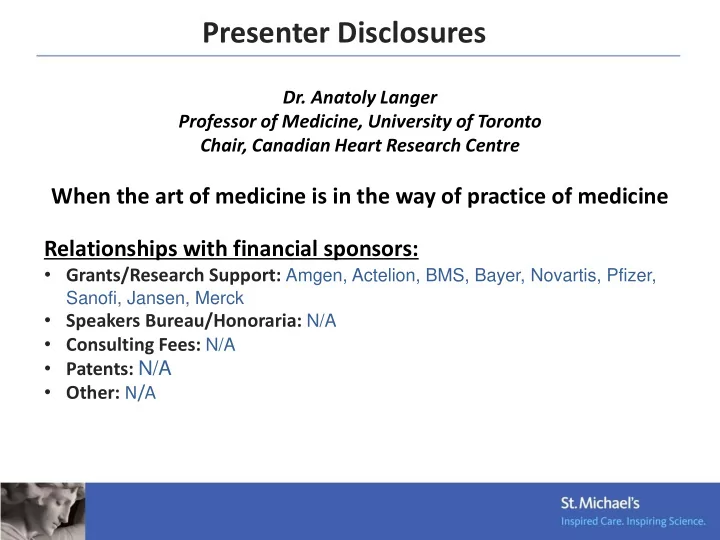

Presenter Disclosures Dr. Anatoly Langer Professor of Medicine, University of Toronto Chair, Canadian Heart Research Centre When the art of medicine is in the way of practice of medicine Relationships with financial sponsors: • Grants/Research Support: Amgen, Actelion, BMS, Bayer, Novartis, Pfizer, Sanofi, Jansen, Merck • Speakers Bureau/Honoraria: N/A • Consulting Fees: N/A • Patents: N/A • Other: N/A
Problem in need of solution • There is a care gap between the actual care (the art) and evidence-based (guidelines recommended) care. • The observed care gap, as it relates to physicians, may result from relative lack of knowledge or from treatment inertia. • Solution: empower and support physicians in optimizing their management.
Performance Matters! Relationship between Process and Outcome In-hospital Mortality 8 n=45,987 with NSTEACS, 403 U.S. hospitals, Apr 2000-03 % of Patients p<0.0001 6 5.89 4.98 4.55 4 3.57 2 0 <65% 65-75% 75-80% >80% Hospital Composite Adherence* Quartiles * Use of 9 ACC/AHA Class I care indicators among eligible pts without contraindications (adjusted for pt + hospital features) Adapted from Peterson et al J Am Coll Cardiol 2004;43(suppl.):406A
Performance Matters! Changes in Hospital Non-ST ACS Guideline Adherence and Patient Outcomes Relative Change in Hospital Mortality Rates (%) 10 p<0.0001 +3.1 0 -2.4 Every 10% in guidelines adherence → 11% in -10 mortality -20 n=21,588 from 315 U.S. -28 hospitals participating -30 for ≥3 quarters -37 -40 Hospital Quartiles: 1 (N=78) 2 (N=79) 3 (N=79) 4 (N=79) Absolute Change in Guideline Adherence: -4.6% (worse) +1.8% (better) +6.8% (better) +15.6% (better) Peterson et al Circulation 2004;110:III-785
GUIDANCE Ezetimibe in LDL-C Care gap Inclusion Criteria: 1. High Risk (60% DM) 2. On stable statin dose already 3. LDL not at target Algorithm: 1. Optimize Statin 2. Add CAI (ezetimibe) Katz et al GUIDANCE Can J Cardiol 2011 (27): 138 – 145
Achieving the Target LDL Ezetimibe was started or continued on top of statin (100%) 26.7% 33.7% 37.7%
Physician and Patient Distribution N = 248 MDs: n = 2,009 high risk with/for CVD: - 60% PCP - on maximally tolerated statin - 40% Specialists ≥ 3 months Intervention: - LDL- C ≥ 2 mmol/L - Educational - Will you follow the Patients with: guidelines and 1. ASCVD: CAD, AAA, PAD, CeVD or if not why not? 2. FH Quebec N=14 British Manitoba Nova Scotia Nova Scotia Alberta n=108 Columbia N=5 Ontario New N=1 N=2 N=13 Sask. N=21 n=49 N=115 Brunswick n=0 n=19 n=90 N=3 n=169 n=1545 N=5 n=6 n=41 Langer et al, Can J Card Open 2020;2:49-54)
Impact of the implementation science: LDL-C reduction 5 P value < .0001(repeated measures ANOVA) 4.5 4 1 mmol/L ↓ in 3.5 3.3 LDL = 20% ↓ in CV Mortality 3 (mmol/L) from 4.5% to LDLC 3.5% (Lancet 2.4 2.5 2005 Oct 8; 2.2 366:1267-78) 2 1.5 1 GOAL: over 20 lives will 0.5 be saved 0 over 5 years Visit 1 Visit 2 Visit 3 n=2,027 n=1,763 n=1,517 Langer et al, Can J Card Open 2020;2:49-54)
Care Gap: Lipid Modifying Therapy % Atorvastatin (10/20/40/80 mg) 28 (4/5/8/11) Rosuvastatin (5/10/20/40 mg) 40 (5/11/12/12) Pravastatin (10/20/40 mg) 5 (1/1/2) Simvastatin (5/10/20/40/80 mg) 3 (<1/1/<1/1/<1) Fluvastatin (20/40 mg) 1 (<1/1) Lovastatin (20/40 mg) <1 (<1/<1) No statin 24 Ezetimibe 26 Bile Acid Sequestrant 5 Fibrate 3 Niacin <1 Langer et al, Can J Card Open 2020;2:49-54)
Additional Lipid Modifying Therapy 50 Visit 1: Baseline (n=2,027) 41.1 Visit 2: 6-16 weeks (n=1,763) 39.4 40 Visit 3: 18-30 weeks + (n=1,517) + ≥6 weeks post Visit 2 % of Patients 30 27.6 25.5 23.1 20 10 5.2 4.9 5.1 2.7 2.7 2.7 0.7 0.4 0.5 0 0 Ezetimibe BAS Fibrate Niacin PCSK9 Inh. Langer et al, Can J Card Open 2020;2:49-54)
% of Patients Achieving LDL-C Target* * ≤2.0 mmol/L by Canadian Cardiovascular Society Guideline Recommendations 100 80 % of Patients 60 50.9 40 41.8 20 0 0 Visit 1 Visit 2 Visit 3 n=2,009 n=1,763 n=1,517
Care Gap: Reasons for not prescribing PCSk9 inhibitor Ezetimibe Reasons “why not” Visit 1 / Visit 2 Visit 3 Visit 1 / Visit 2 Visit 3 (N=461) Baseline (N=811) (N=671) Baseline (N=583) (N=947) (N=915) Not needed 27.1 20.7 18.9 22.1 20.4 22.1 Patient refused 24.8 41.2 44.1 32.5 40.5 39.9 Will prescribe 18.4 10.9 6.9 14.0 8.4 5.7 next visit Cost 26.2 23.9 24.9 9.3 5.8 3.9 Co-morbidities 1.1 0.7 2.2 1.2 1.4 1.5 Patient intolerant 1.5 2.2 3.0 20.5 23.2 26.5 Social constraint 0.6 0.4 0 0.1 0 0.2 Believe management 0.3 0 0 0.3 0.3 0.2 is appropriate Langer et al, Can J Card Open 2020;2:49-54)
CV Medications based on LDL target achievement Overall LDL-C target LDL-C target p (N=2009) not achieved at achieved at last available last available visit (N=1138) visit (N=871) ACE Inhibitor 38.2% 34.1% 43.5% <.0001 Angiotensin receptor 22.4% 22.9% 21.8% 0.58 blockers Beta-blocker 39.1% 33.6% 46.4% <.0001 Calcium Channel Blocker 22.4% 21.1% 24.0% 0.12 Diuretic 19.0% 20.3% 17.2% 0.08 Antiplatelet therapy 61.3% 55.5% 68.8% <.0001 Anticoagulant therapy 7.2% 7.2% 7.2% 0.98 Langer et al, Can J Card Open 2020 (in press)
Summary: To treat is to be burdened with the care gap (Langer May 2nd, 2020 :) • The care gap is universal. • Most physicians are open minded to addressing the care gap but require support: education, standing orders, reminders, and physician assistants. • Patient engagement is needed outside of physician visit: public campaigns (the cost of undertreatment and misinformation), sharing of the treatment plan and therapeutic journey. • Better medications with better compliance: injectables over pills.
Thank you!
Recommend
More recommend